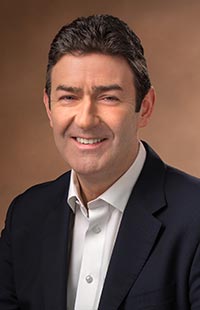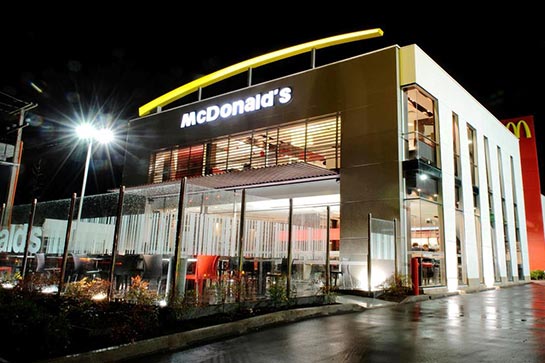The business downturn continues for McDonald’s Corporation, as the Oak Brook, Illinois, USA-headquartered company recently reported that comparable sales decreased 0.6% in April. While turnover rose 1% in Europe for the world’s largest quick service restaurant chain, sales fell 2.3% in the United States and 3.8% in the Asia/Pacific, Middle East and Africa (APMEA) market.
“While our current performance reflects the significant work ahead, I am confident that we’ve taken the first critical steps toward positioning the company for long-term profitable growth,” commented Steve Easterbrook, president and ceo.
 Steve Easterbrook, president and ceo of McDonald’s Corporation, is confident that long-term financial growth lies ahead for the world’s largest QSR chain.Easterbrook said that to improve sales in the US the company is moving to leverage its decentralized operating structure and “simplify menu and consumer insights to deliver value initiatives and menu offerings that resonate with the local markets.”
Steve Easterbrook, president and ceo of McDonald’s Corporation, is confident that long-term financial growth lies ahead for the world’s largest QSR chain.Easterbrook said that to improve sales in the US the company is moving to leverage its decentralized operating structure and “simplify menu and consumer insights to deliver value initiatives and menu offerings that resonate with the local markets.”
Europe’s comparable sales rose 1% in April as solid results in the United Kingdom and Germany were partly offset by negative performances in France and Russia. McDonald’s Europe continues to target opportunities to enhance promotional menu options and build on its value, breakfast and family business amid ongoing macro-economic headwinds across much of the segment.
In APMEA, comparable sales declined 3.8% in April due to continued challenges in Japan partly offset by strong results in Australia and other markets. Strengthening McDonald’s quality and value perceptions remains a top priority in the APMEA sector.
Strong comparable sales in McDonald’s Other Countries & Corporate segment, which includes Latin America and Canada, contributed positively to the company’s global comparable sales performance for the month.
While systemwide sales in April decreased 8.8%, the bottom line was a 1.5% increase in constant currencies.
Meanwhile Easterbrook, a 20-year McDonald’s veteran who returned to the company on March 1 to succeed retiring Don Thompson, has outlined a number of initial steps in a turnaround strategy that will include a restructuring of the worldwide business and financial updates.
“As we look to shape McDonald’s future as a modern, progressive burger company, our priorities are threefold – driving operational growth, returning excitement to our brand and unlocking financial value,” said the chief executive officer. “The immediate priority for our business is restoring growth under a new organizational structure and ownership mix designed to provide greater focus on the customer, improve our operating fundamentals and drive a recommitment to running great restaurants. As we turn around our business, we will look to create more excitement around the brand and ensure that we build on our rich heritage of positively impacting the communities we serve.”
New Market Segments
Easterbrook continued: “The first critical step of our operational growth-led plan is to strengthen our effectiveness and efficiency to drive faster and more customer-led decisions. We will restructure our business into four new segments that combine markets with similar needs, challenges, and opportunities for growth.”

As such, beginning on July 1, McDonald’s will operate under a new organizational structure with the following market segments:
- United States. This the company’s largest segment, accounting for more than 40% of operating income in 2014;
- International Lead Markets – established markets including Australia, Canada, France, Germany and the UK, which operate within similar economic and competitive dynamics, offer similar growth opportunities and collectively represented about 40% of the company’s 2014 operating income;
- High-Growth Markets – areas with relatively higher restaurant expansion and franchising potential including China, Italy, Poland, Russia, South Korea, Spain, Switzerland and the Netherlands. Together these countries accounted for about 10% of the company’s 2014 operating income;
- Foundational Markets – the remaining regions in the McDonald’s system, each of which has the potential to operate under a largely franchised model. Corporate activities will also be reported within this segment.
 Easterbrook added, “Our new structure will be supported by streamlined teams with fewer layers and less bureaucracy, and our markets will be better organized around their growth drivers, resource needs and contributions to the company’s overall profitability. McDonald’s new structure will more closely align similar markets so they can better leverage their collective insights, energy and expertise to deliver a stronger menu, service, and overall experience for our customers.”
Easterbrook added, “Our new structure will be supported by streamlined teams with fewer layers and less bureaucracy, and our markets will be better organized around their growth drivers, resource needs and contributions to the company’s overall profitability. McDonald’s new structure will more closely align similar markets so they can better leverage their collective insights, energy and expertise to deliver a stronger menu, service, and overall experience for our customers.”
Segment Leadership Team
The ceo announced the leadership team for the new segments, effective July 1, as follows:
- Mike Andres will continue to serve as president for McDonald’s operations in the United States. “He is a progressive, strategic thinker with the vision necessary to capitalize on the opportunities in the US market,” said Easterbrook.
- Doug Goare, currently president of McDonald’s Europe, will become president of international lead markets.
- Dave Hoffmann, now serving as president of McDonald’s APMEA region, will transition to the role of president for high-growth markets. “Dave is a results-oriented leader with outstanding experience building the brand in emerging markets like China,” said Easterbrook. “He is uniquely qualified to lead this new segment in pursuing the tremendous opportunities that exist for McDonald’s across this group of markets.”
- Ian Borden, presently McDonald’s APME’s chief financial officer, will assume the position of president for foundational markets. In this role, he will be responsible for maximizing the potential of approximately 100 markets that currently account for about 10% of the company’s operating income. Borden brings very broad geographical and functional expertise to the job, having worked in Canada, Europe and APMEA in various finance and operations leadership positions.
New Refranchising Targets “As we restructure our organization and instill greater customer focus, McDonald’s turnaround will be governed by stronger financial discipline, faster decision making and clear management accountability,” said Chief Administrative Officer Pete Bensen. “This new organization structure will unleash more entrepreneurial spirit and more innovation across our system, while bolstering what makes us a formidable leader in the industry: our incredible network of dedicated franchisees.”
“As we restructure our organization and instill greater customer focus, McDonald’s turnaround will be governed by stronger financial discipline, faster decision making and clear management accountability,” said Chief Administrative Officer Pete Bensen. “This new organization structure will unleash more entrepreneurial spirit and more innovation across our system, while bolstering what makes us a formidable leader in the industry: our incredible network of dedicated franchisees.”
The enhancements to McDonald’s operating approach will be accompanied by plans to further optimize the company’s restaurant ownership mix, deliver G&A savings and accelerate cash returned to shareholders. Specifically, the McDonald’s expects to:
- Refranchise 3,500 restaurants by the end of 2018, accelerating the pace of refranchising and increasing the global franchised percentage from the current 81% to about 90%. This marks a significant step forward from the company’s prior plan to refranchise at least 1,500 restaurants by 2016;
- Deliver approximately $300 million in net annual G&A savings, most of which will be realized by the end of 2017, in connection with the company’s organizational restructure, refranchising strategy, and more stringent discipline around spending throughout the organization;
- Return $8 billion to $9 billion to shareholders in 2015 and reach the top end of McDonald’s three-year $18 to $20 billion cash return to shareholders target by the end of 2016.
McDonald’s is ranked as the world’s leading global foodservice operator, with more than 36,000 locations serving approximately 69 million customers in over 100 countries each day. More than 80% of McDonald’s restaurants worldwide are owned and operated by independent local businessmen and women.





